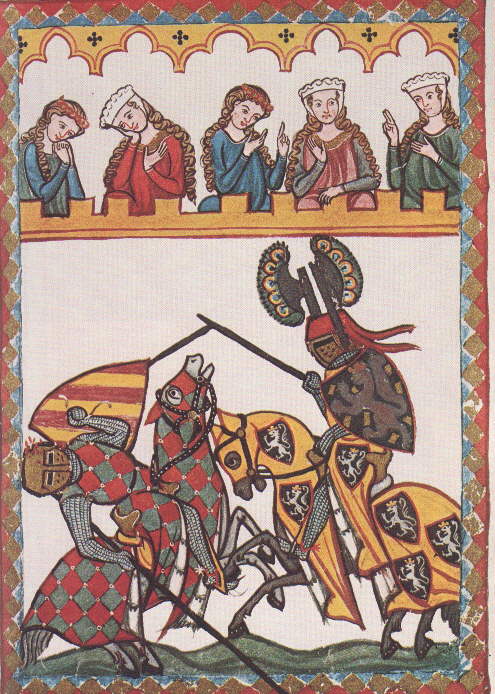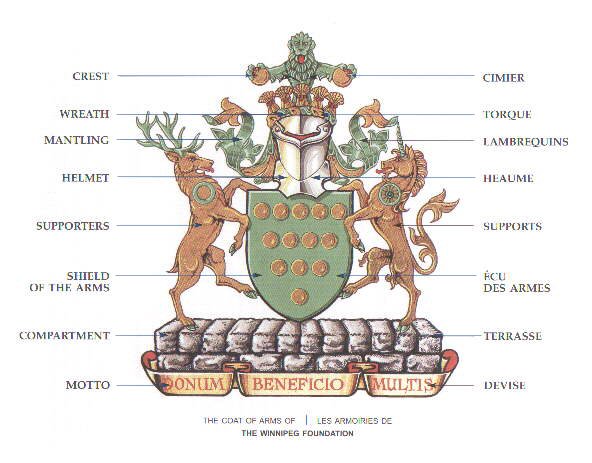What is Heraldry?

What is a Coat of Arms?
A coat of arms is a form of personal or corporate identification of which the central element is a shield. Its roots are in the Middle Ages and its design and symbolism follow traditional channels, but its use can be as modern as this website. While it can be considered as a sort of personal trademark or logo, it differs from either a trademark or logo in four important ways:
- Because its symbolic devices are essentially timeless, it does not become outdated by advancing technology or changing lifestyles. A coat of arms granted in the fifteenth century looks just as fresh - just as modern - as one designed yesterday.
- Because it is a true art, its depiction may vary widely from one artist to another, allowing for a number of interpretations and for changes in artistic taste over time.
- Because - at least in the case of personal arms - it is hereditary.
- Because it is a grant from the Crown or State and cannot merely be assumed, changed, or discarded at will.
How Did Heraldry Develop?
The evidence strongly suggests that heraldry as we now recognize it began in the early 12th century, largely because of the development at that time of helmets that covered and concealed the face of the wearer.
Knights in battle - and more importantly in the mock warfare of the tournament - started identifying themselves by painting devices on their shields. These devices were shortly extended to the surcoats worn over armour (hence the "coat" in "coat of arms"), to the bardings of warhorses and even to the clothing of wives.
A little later, it became customary for Knights to attach devices to the tops of the "great helms", worn mainly in tournaments, and these additional identifying symbols became known as "crests" as depicted in the image on the left.
The shield and crest combined (together with a number of other elements discussed below), made up what came to be known as the "heraldic achievement" - or just simply the "coat of arms".
The Regulation of Arms
To prevent the inevitable duplication resulting from individual selection, the design and regulation of arms soon came under the jurisdiction of the heralds, the officers who ran the tournaments - hence the name heraldry. Later, when the practice became widespread in Europe - and given the free movement of Knights from tournament to tournament - it was taken over by the sovereign of each state, through senior heralds known as "kings of arms". This practice ensured (at least in theory) that no two knights could use the same arms. This became increasingly important, since the wearing of a surcoat bearing the owner's arms became a life-saving practice during the warfare of the 15th century. At that time, most experienced soldiers had abandoned face-concealing helmets (great helms and visored bascinets) during actual warfare, in the interests of improved vision, and shields were becoming less popular. However, the wearing of a surcoat of arms marked the wearer as someone for whom a ransom was likely to be paid and therefore worth much more alive than dead.
Other Elements
Quite early on, knights started adding Mottoes to depictions of their arms, usually on a scroll below or above the arms. In the late 15th century, certain nobles began placing animal or human figures on either side of their shields and these became known as "supporters". The ground upon which they stood was known as the "compartment" and was sometimes used as the repository of symbolic devices for which there was not room elsewhere in the achievement. These practices persist today, although the grant of supporters has traditionally been restricted to persons of high rank or status.
Note that supporters are normally restricted to persons of high rank and that, without supporters, there is no compartment. Note also that the crest is only that part of the coat of arms above the helmet and should not be used as a term to describe the whole thing. To view a larger version of the achievement image, click on the image on the left.
Corporate Arms
Starting with ecclesiastical bodies and later with the mediaeval guilds, the use of heraldry soon spread beyond the personal use of knights to the corporate use of institutions and municipalities - one of its most frequent uses in modern times.
Ownership of Arms
One of the commonest questions asked about heraldry is, "How do I find my family's coat of arms?" (or, alternatively, "...the arms of Smith?"). The answer is - "There is no such thing!". As far as personal arms go, they are granted to a single individual, not to a family or surname. The original arms may be passed on to a designated heir on the death of the owner and his other descendants may use similar but not identical features in their own arms, but a specific coat of arms can only belong to a single person at any time. Even if a coat of arms can be found associated with your surname, it almost certainly does not belong to you personally, unless you can prove direct, lineal, male-line descent from the original grantee. It must be repeated over and over - "FAMILY ARMS" DO NOT EXIST!
- The Die Manessesche Liederhandschrift or "Manesse Song Handwriting" was created between 1300 and 1315 by a group of four (4) artists and their assistants in the area of Zurich, Switzerland which now resides at the Universitätsbibliothek, Heidelberg in Germany. The 137 paintings depict the attributes of normal, everyday life of the period, that included work, play and battle. It also provides some clues of tournaments, the attitudes of the spectators and the manner in which tournaments were held. Interesting aspects of a number of plates is their similarity to the I.33 illustrations. Universitätsbibliothek, Heidelberg, MS Cod. pal. Germ 848
- The College of Arms, also known as the College of Heralds, founded by royal charter in 1484 by King Richard III, is a royal corporation consisting of professional officers of arms, with jurisdiction over England, Wales, Northern Ireland and some Commonwealth realms. The heralds are appointed by the British Sovereign and are delegated authority to act on behalf of the Crown in all matters of heraldry, the granting of new coats of arms, genealogical research and the recording of pedigrees.









